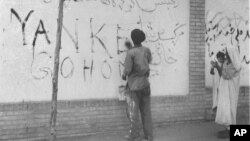A court in Tehran has ordered the U.S. government to pay $330 million in damages for "planning a coup" against the newly established Islamic republic in 1980, the judiciary said Saturday.
A year after the 1979 Islamic revolution that toppled the U.S.-backed shah, a group of mostly army officers tried to overthrow the new government.
State news agency IRNA said the "insurgents" were led by Saeed Mahdiyoun, a former Iranian air force commander, and had their headquarters in Nojeh, an air base in the western Hamedan province.
Several people were killed in clashes between the coup plotters and government forces, and scores of others were arrested.
"Their objective was to seize control of military bases across the country and target strategic centers and residences of the revolution’s leaders. However, their efforts were thwarted," IRNA said.
Court orders damages
Last year, relatives of those killed in the coup attempt filed a legal petition with Iran's International Court demanding damages, the judiciary's Mizan Online website said.
They specifically accused the United States of "planning and executing" the coup, Mizan said.
The court ruled in their favor, ordering "the American government to pay the plaintiffs 30 million dollars in material and moral damages, and 300 million dollars in punitive damages," it added.
Tehran and Washington have had no diplomatic relations since the aftermath of the 1979 revolution.
Fractured relations
In 1953, the British and U.S. intelligence services orchestrated the overthrow of Prime Minister Mohammad Mossadegh who had nationalized Iran's lucrative oil industry.
In 2016, the U.S. Supreme Court ordered that Iranian assets frozen in the United States should be paid to victims of attacks Washington has blamed on Tehran, including the 1983 bombing of a U.S. Marine barracks in Beirut and a 1996 blast in Saudi Arabia.
In March this year, the International Court of Justice ruled that Washington's freezing of funds belonging to several Iranian individuals and companies was "manifestly unreasonable."
But it ruled it had no jurisdiction to unblock nearly $2 billion in Iranian central bank assets frozen by the United States.
Tehran, which denies all responsibility for the attacks blamed on it by the United States, says that a series of U.S. court judgments have awarded victims a total of $56 billion in damages.










